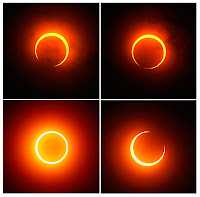
January 26, 2009--The dark disk of the moon creeps across the setting sun during the first solar eclipse of 2009, as seen on Monday from Manila Bay in the Philippines.
People viewing from the southern Indian Ocean were among the few to see the full annular eclipse, so called because at its peak the eclipse is surrounded by an annulus, or ring, of fiery light.
Because the moon's orbit is elliptical, its distance from Earth--and thus its apparent size--varies over time. Annular eclipses happen when the moon looks too small to completely cover the sun, an event that occurs about 66 times a century.
 A sequence of photos shows the moon passing between Earth and the sun before, during, and after an annular eclipse, as seen on January 26, 2009, from Bandar Lampung in Indonesia.
A sequence of photos shows the moon passing between Earth and the sun before, during, and after an annular eclipse, as seen on January 26, 2009, from Bandar Lampung in Indonesia.
The path of the full annular eclipse crossed mostly open ocean in the southern part of the globe, starting about 560 miles (900 kilometers) south of Africa and not reaching land until it crossed Australia's Cocos (Keeling) Islands in the Indian Ocean.
Still, observers in southern Africa, Madagascar, Australia, and Southeast Asia were able to watch a partial eclipse. Astronomer Jay Pasachoff used a specially equipped camera to capture images of the January 26, 2009, annular eclipse from the Indonesian island of Java.
Astronomer Jay Pasachoff used a specially equipped camera to capture images of the January 26, 2009, annular eclipse from the Indonesian island of Java.
Pasachoff, chair of the International Astronomical Union's working group on eclipses, has received funding from the National Geographic Society's Committee for Research and Exploration to study the sun during the total solar eclipse on July 22, 2009. (The National Geographic Society owns National Geographic News.)
"There is little scientific research that can be done at annular eclipses, unlike the situation with total solar eclipses, when otherwise invisible parts of the sun come into view," Pasachoff told National Geographic News in an email.
But annular eclipses can be important, he added, for practicing photography techniques and for getting the public excited about astronomy. Haze blurs the bright ring around an annular eclipse on January 26, 2009.
Haze blurs the bright ring around an annular eclipse on January 26, 2009.
The image was captured from Anyer Beach on the Indonesian island of Java, one of the few places where the solar eclipse was completely visible.
Crowds gathered across Indonesia to witness the event, some cheering and banging drums as the moon seemed to cross the face of the sun, the Associated Press reported.
"I'm old, but I still think this is magical," resident Roanna Makmur, 66, told the AP. "Anyone who passed up this opportunity really missed out."
snow fall
World Clock
ENDLESS TIME
THe Endless World Link
Posted by
Excelsior
0 comments:
Posting Komentar